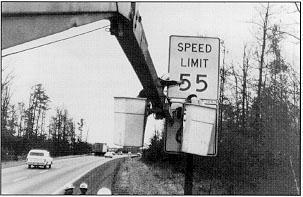
The National Speed Limit: Boon to Drivers, not Bane
In 1974, the federal government put in place a National Maximum Speed Limit Law. It capped the speed drivers could go at 55 miles per hour. Passed at the height of the fuel crisis, the law was a measure many predicted would significantly slash fuel use and reduce fatal accidents. Neither happened. Fuel usage fell by approximately .5%, fatal accidents had no appreciable declines, and the duty of setting speed limits was re-delegated to the states in 1995. Now, the world faces a similar oil situation. Prices are rising; global stores of fossil fuels are falling. Accidents claimed the lives of 32,788 Americans in 2010. Although this represented the lowest rate since 1949, it still made motor vehicle accidents among the top five most common causes of death in the United States. Reinstating a lower national speed limit suddenly doesn't seem like such a bad idea after all. Cars usually achieve maximum fuel efficiency between 40 and 60 miles per hour. However, speed limits run at 65 mph on many interstates. Combine this with the unwritten rules of the road that move the flow of traffic at 5-15 mph in excess of the highway limit, and you have a gas-guzzling result.One of the biggest issues with the 1974 law was the lax enforcement. Penalties were devised by the states. In protest, eight states (Arizona, Idaho, Montana, Nevada, Utah, Minnesota, and both Dakotas) created legislation effectively circumventing all the major tenets of the law, while many others provided no new training or instructions to police officers to help deal with the new provisions. These rebellions may have had a significant effect on the lack of positive results stemming from the measure. If robust enforcement was paired with a new law to create a maximum national speed limit somewhere between 55 and 65 miles per hour, the results could potentially be dramatic. Australia, Denmark, Germany, Sweden, Switzerland, and the UK have all reported positive safety benefits from reduced speed limits in recent years, including reduction of crashes (by up to 20%), crash injuries (by up to 19%), and fatal crashes (by up to 24%). If similar implementation and results were to take place in the United States, that would account for 7,869 lives saved per year. Apart from the obvious humanitarian interest, monetary benefits could include lower gas prices and high revenue from speeding tickets in the transition period to lower speeds. A resurrected National Maximum Speed Limit Law is a common sense idea. It just has to include sufficient enforcement to reap its maximum benefits: a safer society with more prosperity.







